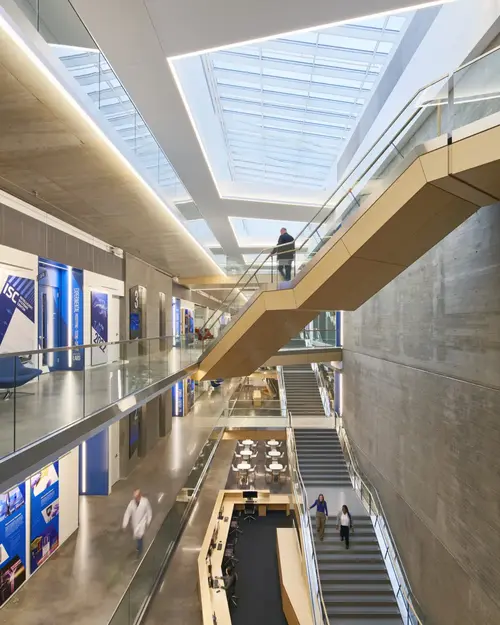Building Innovation: Designing Spaces for Innovation and Discovery
Jan. 23, 2024 —A space is more than walls and windows. It’s an environment that helps shape human interaction, innovation, and discovery. Intentional, human-centered design can influence behavior where people work better in corporate and academic spaces around the world. We’ve previously explored the importance of place in driving innovation, with specific attention to face-to-face, serendipitous encounters and overarching, regional definitions of place. But what about spaces curated for collaborative work, from laboratory space to common areas, and how do the buildings contribute to collaboration, innovation, and discovery?
—A space is more than walls and windows. It’s an environment that helps shape human interaction, innovation, and discovery. Intentional, human-centered design can influence behavior where people work better in corporate and academic spaces around the world. We’ve previously explored the importance of place in driving innovation, with specific attention to face-to-face, serendipitous encounters and overarching, regional definitions of place. But what about spaces curated for collaborative work, from laboratory space to common areas, and how do the buildings contribute to collaboration, innovation, and discovery?
Intended for innovation
Research and development take many shapes, and so does the space where discovery happens. A recent whitepaper by Regal Leftwich, vice president/laboratory planner at UIDP community partner CannonDesign, takes an imaginary tour through the “Co-Lab,” exploring the emerging trends in science and engineering building design. The Co-Lab offers a front-seat design view of common areas and spaces for research, making/incubating, and teaching/learning. Specialized research equipment comes with customized requirements, but design goes beyond the specs with features to foster great outcomes, collaboration, and innovation for each area.
The Co-Lab common areas combine food, art, comfort, and daylight, all elements that lend themselves to creativity, conversation, and chance encounters. The research spaces are flexible, with movable walls and roll-up doors to account for changing research needs. Biophilic building design—connecting people to the natural world—leverages access to nature and natural light to create a feeling of openness where stress disappears and ideas can flow. Co-Lab offers readily available enhanced audiovisual tech to capture and transcribe ideas, ensuring no breakthrough moments are lost. These design elements create an ecosystem conducive to scientific research and adaptable to the changing needs of collaboration and innovation while fostering a comfortable setting that encourages creativity.
Real-life research
You can see many Co-Lab concepts—designed spaces for the social and scientific processes involved in research and collaboration—in the Applied Physics Laboratory at Johns Hopkins University. CannonDesign created the four-story atrium as a focal point that connects both horizontally and vertically, an open approach enabling a view of the work from floor to floor. The labs feature floor-to-ceiling windows, displaying the array of activities occurring within. The space encourages visual connectivity and interaction between scientists.

The atrium in the Applied Physics Laboratory at Johns Hopkins University. © Christopher Barrett Photography / CannonDesign
Regal Leftwich said the company’s approach is to create a versatile space that meets the needs of its users while accelerating scientific discovery.
“Living-Centered Design seizes opportunities through the lens of the broader ecosystems they exist within—helping organizations and communities realize more impactful, systematic change,” he said. “Our approach focuses on supporting the aspirations of an organization’s research culture and design from the inside out, with culture and research functionality at the heart of the process.”
The approach is anchored in a history of design that fosters innovation. For more than 30 years, IBM’s Almaden, CA campus has made its mark as a center for cross-disciplinary innovation, beginning with the world’s first hard disk drive. Computer scientists, chemists, artists, biologists, mathematicians, and doctors collaborate in buildings that appear to blend into the surrounding scenic hills. Inside, walkways open into unexpected, expansive views of the countryside. Generous, configurable collaboration spaces use natural materials to bring the outdoors in while an ample supply of wheeled white boards remain close at hand to capture the next big idea. Spaces are more than simply a place to work; structure should follow function no matter the activity.
Why it matters
Where you work can be a catalyst or roadblock for collaboration, and research spaces like those created for these UIDP member organizations are no exception. Intentional design brings together elements conducive to reduce stress and enable creativity. Every lab and common area on a research campus is a potential birthplace for the next scientific breakthrough.
We want to hear from you. How has your organization designed spaces for research and discovery? Let us know on our LinkedIn profile.


